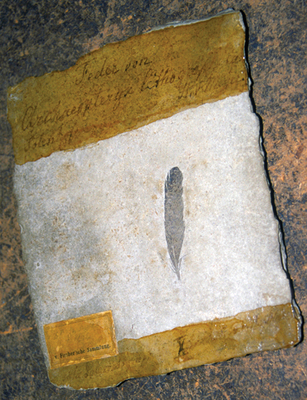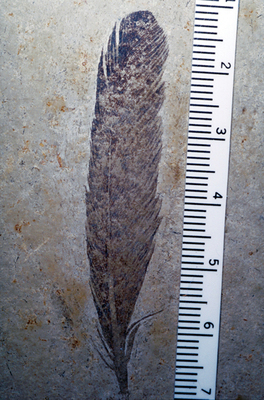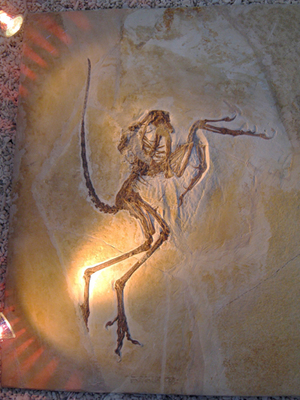
by David B. Williams Thursday, January 5, 2012

_Archaeopteryx _was first discovered and described in 1861. WitmerLab at Ohio University

_Archaeopteryx _was originally identified based on the fossil of a single feather. WitmerLab at Ohio University

_Archaeopteryx lithographica_, Solnhofen specimen, as displayed at the Munich Mineral Show in Germany in 2009. H. Raab, Creative Commons Attribution-ShareAlike 3.0 Unported
The Solnhofen limestone of southern Germany has a storied history. First quarried nearly 2,000 years ago by the Romans, the dense, fine-grained stone gained fame in the early 1800s for its use in lithography. In 1798, Alois Senefelder discovered that a combination of acid etching and drawing with a wax crayon allowed him to create a surface that produced highly precise images. So valued is the Solnhofen lithographic limestone that people still use it today despite the development of cheaper and simpler techniques.
The discovery for which the limestone is most famous, however, came in the summer of 1861, when an unknown quarryman found a single feather in what was then called the Solnhofen Community Quarry. The precisely detailed fossil had left impressions on two slabs of tan limestone. It was slightly asymmetric with a curved shaft, indicating that it was a flight feather. Judging from its size — about that of a modern magpie’s flight feather — the specimen probably came from a young bird, concluded German paleontologist Hermann von Meyer, who obtained the fossil sometime in 1861.
We do not know how von Meyer acquired the fossil. Neither do we know who collected it nor when they found it. But on Aug. 15, von Meyer wrote a letter to Heinrich Bronn, editor of the journal Neues Jahrbuch für Mineralogie, Geologie und Palaeontologie, in which he made the first description of the fossil. Von Meyer wrote that the feather “would be the first remnant of a bird from pre-Tertiary times,” the first sign of the existence of birds from so early in the fossil record.
Six weeks later, on Sept. 30, 1861, von Meyer wrote a second letter to Bronn. After a more thorough study, he concluded that the Solnhofen specimen “is a real fossil … and perfectly agrees with a bird’s feather.” Von Meyer added that he had recently learned of the discovery of a complete skeleton of an animal with feathers from the same stone. Finally, and specifically addressing the feather, he noted, “for the name of the animal I consider Archaeopteryx lithographica as appropriate.”
Although von Meyer designated the species name for the single feather, the initial fame for Archaeopteryx rested with the full body specimen he mentioned in his second letter to Bronn. As with the feather, we do not know who found this fossil or when they found it. It appears to have merited outside attention sometime between July 15 and Sept. 1, 1861, writes the world’s expert on Archaeopteryx, Peter Wellnhofer, in his 2009 book “Archaeopteryx: The Icon of Evolution.”
During summer 1861, jurist and amateur paleontologist Friedrich Witte visited another fossil collector, Karl Häberlein, who owned the full-body fossil. Witte immediately contacted von Meyer. He also tried to convince Andreas Wagner, director of the Paleontology Collection of the State of Bavaria in Germany, to buy the Archaeopteryx from Häberlein.
Wagner sent his assistant Albert Oppel to see the specimen, and based on his drawing and description, Wagner concluded that von Meyer had incorrectly labeled the fossil as a bird. In a speech in November, Wagner said, “whether I regarded this mongrel creature as a bird with a tail of a reptile, or as reptile with bird’s feathers; the one was as incomprehensible to me as the other.” Ultimately, he concluded that the fossil was a reptile, which he named Griphosaurus, derived from “griphos,” an enigma.
Wellnhofer writes that Wagner’s conclusion was based on his rejection of Darwin’s theory published just two years earlier in “On the Origin of Species,” which predicted the existence of fossil transitional species. In Wagner’s mind, no such transitional species between a saurian and a bird could exist.
Another critic, Christoph Giebel, a zoology professor at the University of Halle in Germany (now called Martin Luther University of Halle-Wittenberg), went further than Wagner did, questioning the reality of the Archaeopteryx specimen. It looked like someone had taken a real pterosaur skeleton and lithographed in the feather impressions, wrote Giebel. After all, “the stone was perfectly suited for this,” he added.
While the Germans dithered and debated, the British seized the opportunity to contact Häberlein. Encouraged by Britain’s premier paleontologist and anatomist, Richard Owen, the keeper of the geology department of the British Museum, George R. Waterhouse arranged to buy Archaeopteryx, along with Häberlein’s entire fossil collection, totaling 1,756 Solnhofen specimens. Negotiations took more than a year with a final cost of 8,400 Bavarian guldens. At the time, Häberlein’s annual salary as a physician was 60 guldens.
The London Archaeopteryx, as it came to be called, caused quite a commotion. Paleontologist Hugh Falconer wrote to Darwin: “Had the Solnhofen quarries been commissioned — by august command — to turn out a strange being à la Darwin — it could not have executed the behest more handsomely — than in the Archaeopteryx.” Owen, in contrast, believed it to be a bird, though not a transitional species; Archaeopteryx represented one of the ideal archetypes planned by a Creator. For British biologist and staunch Darwin defender Thomas Huxley, however, Archaeopteryx was a transitional species and one that helped show the connection between birds and reptiles
Sixteen years would pass before another Archaeopteryx appeared. Coincidentally, Häberlein’s son acquired that fossil for perhaps as little as 140 marks, about the cost of replacing the family cow. After an initial preparation, he raised the price to 25,710 marks and eventually sold it for 20,000 marks to Werner von Siemens, who made it available to the Berlin Mineralogical Museum. After this second find, known as the Berlin specimen, no others would be discovered until 1956.
Paleontologists have discovered a total of just 10 skeletons and one
feather of
Archaeopteryx. All have come from the Solnhofen limestone, though one
was “discovered” at a museum in Haarlem, The Netherlands. Ironically,
von Meyer had first described this specimen, unearthed in 1855, as a
pterodactyl. Not until Yale paleontologist John Ostrom examined it in
1970 did anyone suspect that it was an Archaeopteryx, or that it was
the first one ever found — though today we consider the original
Archaeopteryx to be the one written about in 1861.
In the 150 years since von Meyer named his 58-millimeter-long feather, Archaeopteryx has become one of the world’s most famous fossils. Outside of the realm of dinosaurs, Archaeopteryx is arguably the best-known fossil. It is certainly one of the few to appear on a coin: On Aug. 11, 2011, Germany issued a special edition 10 Euro coin depicting the Berlin specimen. In addition, as noted earlier, it is the subject of Peter Wellnhofer’s book (published in English by Verlag Dr. Friedrich Pfeil in 2009). Lavishly illustrated and filled with both historical and scientific information, the tome is a fantastic testament to the first bird and the sesquicentennial of its discovery.
Archaeopteryx fossils are also some of the most beautiful and
awe-inspiring because most are stunningly preserved. Washed into lagoons
150 million years ago, the bones settled into stagnant,
hypersaline water. The oxygen-poor environment meant that few critters
were around to disturb the animals in death. As fine-grained mud buried
their bodies, the birds were preserved in exquisite detail, revealing
teeth, ribs, claws and, of course, feathers.
Such preservation may account for the importance of Archaeopteryx at least as much as its status as first bird. Few other animals or plants have left such a pristine record for scientists to study. This preservation has led to Archaeopteryx becoming what one might call a keystone species, one whose impacts on the community are far out of proportion to its relative abundance or total biomass. As a measure of the importance of Archaeopteryx, here’s one final statistic: Searching through the GeoRef index, you can find more than 550 papers citing the old bird compared with a paltry 238 papers for Tyrannosaurus rex. Not bad for an animal with only 10 specimens.
© 2008-2021. All rights reserved. Any copying, redistribution or retransmission of any of the contents of this service without the expressed written permission of the American Geosciences Institute is expressly prohibited. Click here for all copyright requests.